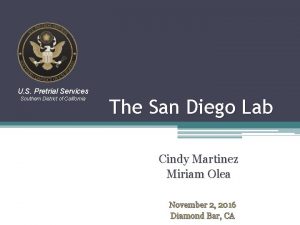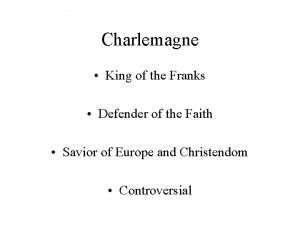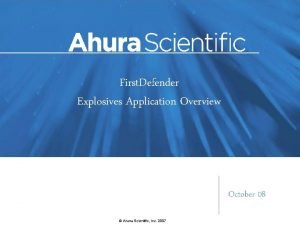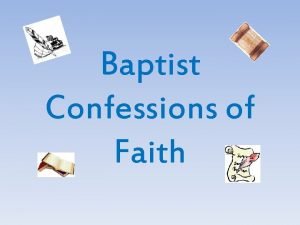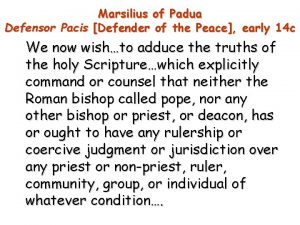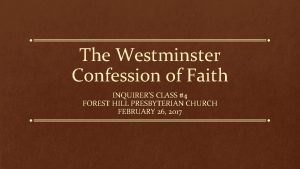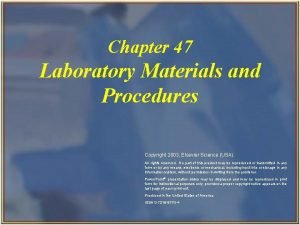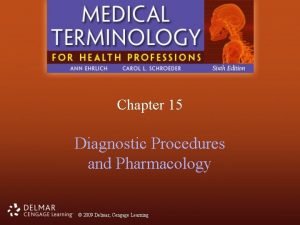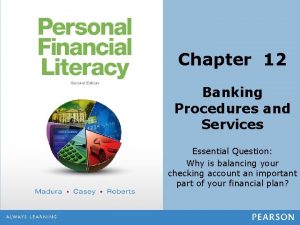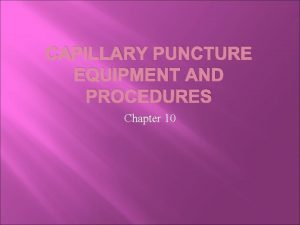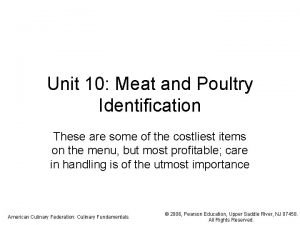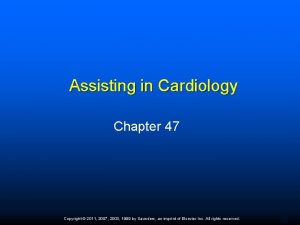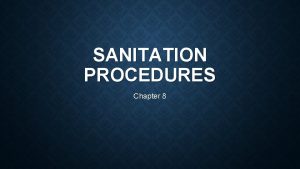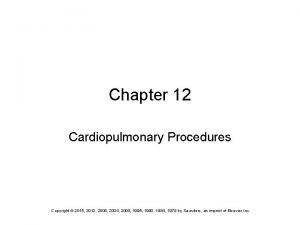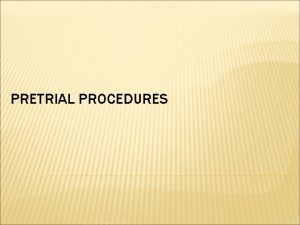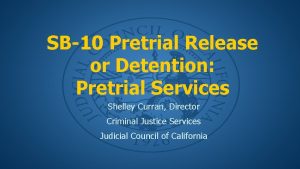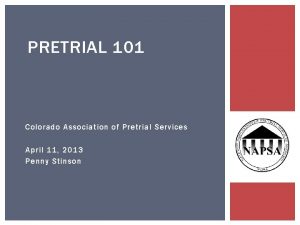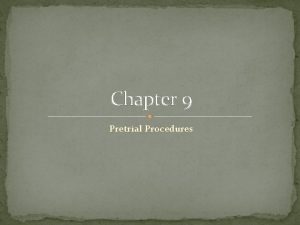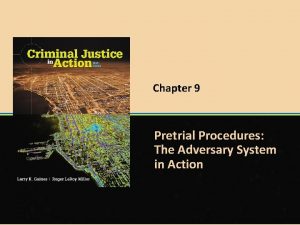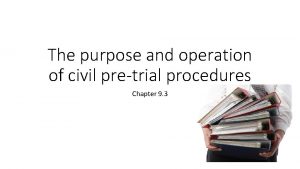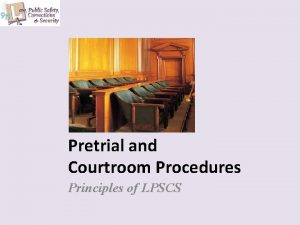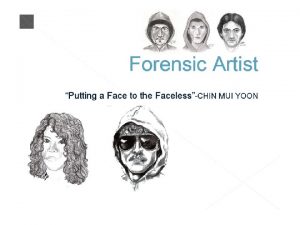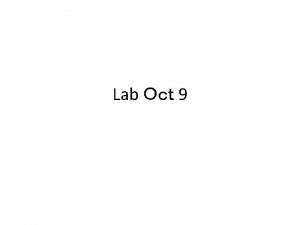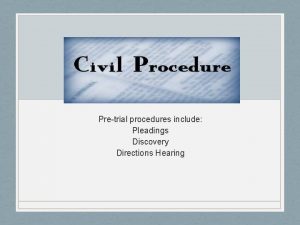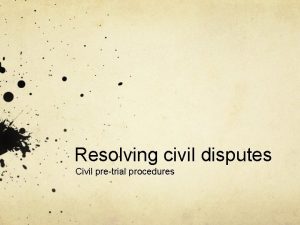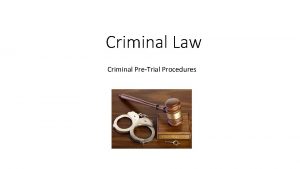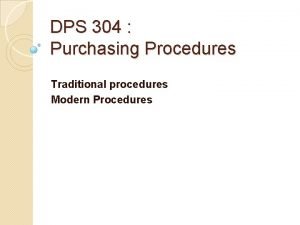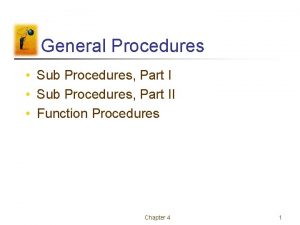Confessions and Pretrial Identification Procedures Chapter 11 The



































- Slides: 35

Confessions and Pretrial Identification Procedures Chapter 11

The Fifth Amendment • “No. . . person shall be compelled in any criminal case to be a witness against himself. . . ” • The burden must rest on the state to prove a person guilty of a crime • The proof must be reliable • The confession by the accused must be supported by extrinsic source

The Fifth Amendment (Continued) • The right against self-incrimination is designed to keep the burden of proof on the state by – Forcing the government to find reliable evidence and – Prohibiting the use of force to coerce a confession

What Does the Fifth Amendment Protection Include? • It protects – Confessions – Self-incriminating testimony • This amendment applies to any civil or criminal proceeding – Includes trials, juvenile delinquency hearing, and death penalty sentencing hearing

What Does the Fifth Amendment Protection Include? (Continued) • Two questions considered by court when deciding whether testimony should be suppressed: • Does the testimony incriminate or prove criminal conduct? • Could the testimony be used in future criminal procedures?

Who Is Protected by the Right Against Self-Incrimination? • It protects natural persons – One can invoke the right for personal statements, acts, or documents – Perjured statements are not afforded Fifth Amendment protection • It does not protect corporations

Incriminating Testimony • Testimony is incriminating when it contributes to the evidence needed to prosecute – The context in which the question is asked is critical in this determination

Invoking the Fifth Amendment • The invocation must be specific • This right must also be consistently asserted

Can Testimony Ever Be Compelled? • Testimony can be compelled in spite of the Fifth Amendment when – The statute of limitation has run on the crime – Immunity has been granted to the defendant • Immunity is a binding promise that a person will not be prosecuted for certain crimes – Once immunity is granted it is binding on all jurisdictions

Types of Immunity • Use Immunity – Restricted to any statements or fruits from those statements that are incriminating and related to a particular crime – Incidental statements that incriminate the defendant in other crimes are not immunized

Types of Immunity (Continued) • Transactional Immunity – This is a broader type of immunity – Immunizes defendant for any statement about any crime • The federal system and many states have stopped giving transactional immunity

Other Times Testimony Can Be Compelled • Statutes may require the reporting and keeping of information that may be incriminating, such as – Information on income tax forms – Information on securities transaction – Industry safety measures

The Extent of the Waiver of the Fifth Amendment • If the defendant waives the right and gives incriminating evidence the defendant cannot then refuse to answer questions posed – Unless the new question will provide a link to other crimes • The waiver of the right does not extend to future hearings or trial

Evidence Protected by the Fifth Amendment • Testimonial evidence is protected • Physical evidence or evidence that is as likely to prove innocence as guilt is not protected – – – – Blood and urine samples Appearing in lineups Wearing particular clothing in lineups Fingerprints Writing or voice samples Stopping at an accident Being photographed Displaying tattoos or scars

Confessions and Miranda • Miranda v. Arizona (1966) • Aggressive protection of right against selfincrimination • The essentials of Miranda – Police must inform people of the right to be silent – Rules apply when a person is undergoing custodial interrogation

The Essentials of Miranda • The four basic rights – – Right to remain silent Statements can be used against them in court Right to an attorney If the person is indigent, the court will provide an attorney • Interrogation must stop if the suspect invokes right to remain silent

The Essentials of Miranda (Continued) • If a statement is made after the defendant invokes the right to remain silent but without an attorney present, that statement is presumed to be coerced • A violation of these rules means the statement will not be admitted into evidence • Confessions and admissions are both protected

The Essentials of Miranda (Continued) • This right also insures that the defendant may remain silent and this cannot be the subject of speculation by the prosecution – Cannot call the jury’s attention to defendant’s silence

Issues Left Unanswered by Miranda • When is a suspect “in custody” for purposes of Miranda? – Courts use a objective standard – Courts must • Consider the circumstances surrounding the interrogation and • Determine whether a reasonable person would have felt at liberty to leave

Issues Left Unanswered by Miranda (Continued) • When does police conduct or speech become “interrogation” and trigger the Miranda rules? – Voluntary statements by the suspect are not interrogation – Interrogation is police action that leads one to conclude that the action is intended to elicit an incriminating response

Issues Left Unanswered by Miranda (Continued) • What if the warning is incomplete or delayed? – Minor deviations from the warning stated in Miranda are not significant – If the person being interrogated is a non-Englishspeaking individual, the Miranda warning must be given in the person’s native language

Public Safety Exception to Miranda • If the circumstances of a case show that there is a threat to public safety, the Court has allowed police officers to interrogate without first giving Miranda warnings

Waiver after Miranda Warnings • A valid waiver is one that is given intelligently and voluntarily • A valid waiver cannot be inferred from silence • A defendant may waive rights by actions as well as words • A defendant may subsequently waive an assertion of Miranda rights

Miranda’s Scope • Miranda applies to any matter that may lead to criminal or punitive charges • It does not protect persons at – Competency hearings – Prison disciplinary hearings – Sexual offender hearings • Statements made to non-police persons are not protected

Use of a Suppressed Statement • Impeachment: an attack on the witness’s testimony • If previous suppressed statement contradicts the in-court testimony, it can be used to impeach the witness by showing: – Witness is lying – Witness is inconsistent

Right to Counsel • Massiah v. U. S. (1964) • Focuses on whether the Sixth Amendment right to counsel has been violated • Applies after a person has been indicted or arraigned • Prohibits the police from eliciting statements from the defendant in violation of the right to counsel

Eliciting Incriminating Statements • May do so by direct questioning • May do so by making an appeal to – Religion – Morality – Decency • Use of seemingly innocent conversations may be eliciting under certain circumstances

Challenging a Confession • This is an issue of law to be decided by the judge • Defense counsel bring pretrial motion to suppress the confession • At the hearing the defendant may testify without giving up the overall Fifth Amendment right against self-incrimination

Requesting and Preparing for a Suppression Hearing • Steps – Gather the facts – Research the law – Draft the motion and memorandum of law • The court clerk will set the date for the hearing

Identification • Three major processes for identification – Lineups – One-on-one show-ups – Photo identifications • Attorney must be present at post-indictment lineups – No requirement for attorney to be present at postidentification photo identification

Identification (Continued) • Right to counsel applies one-on-one confrontation procedures • Right to have counsel present can be waived by the defendant • Exigent circumstances may exist that may supersede the right to counsel • If an identification is ruled unconstitutional, it may be suppressed

Due Process and Pretrial Identifications • An identification may also be unconstitutional if it violates due process • Court will look at “totality of the circumstances” to determine if – Police procedure was too suggestive – The procedure has “irreparable mistakes”

Factors to Be Considered for an Alleged Due Process Violation • Witness’s opportunity to see the criminal at the time of the crime • Witness’s attentiveness • Witness’s accuracy • Witness’s certainty at the identification procedure • The time lapse between the crime and the identification process

Lineups and Photo Identifications • Preferred lineup procedure – Include a minimum of six persons for a lineup and eight for a photo identification – All persons should have similar physical characteristics – Require all participants in the lineup to speak, gesture, and wear certain clothing – Inform all persons viewing the lineup or photos that the guilty person may not be included

Lineups and Photo Identifications (Continued) • Require the person viewing the lineup or photos to view each person or photo separately – Do not allow the person to view them as a group • Police officer conducting the lineup or photo identification should have no knowledge of who the likely suspect is • Limit the viewing to one witness at a time • Photograph/videotape the identification procedure
 Us pretrial services san diego
Us pretrial services san diego Judge robert tejeda
Judge robert tejeda Confessions of a public defender
Confessions of a public defender Bgu confessions
Bgu confessions Ahura first defender
Ahura first defender Types of confessions
Types of confessions Philadelphia confession of faith
Philadelphia confession of faith Bgu confession
Bgu confession Confessions westminster cathedral
Confessions westminster cathedral Central pocket vs plain whorl
Central pocket vs plain whorl Chapter 47 laboratory materials and procedures
Chapter 47 laboratory materials and procedures Chapter 15 diagnostic procedures and pharmacology
Chapter 15 diagnostic procedures and pharmacology Chapter 12 banking procedures and services
Chapter 12 banking procedures and services Capillary puncture equipment
Capillary puncture equipment California finfish and shellfish identification book
California finfish and shellfish identification book Meat and poultry identification worksheet chapter 30
Meat and poultry identification worksheet chapter 30 Chapter 10 workplace safety procedures
Chapter 10 workplace safety procedures Cardiology procedures chapter 47
Cardiology procedures chapter 47 Chapter 8 sanitation procedures
Chapter 8 sanitation procedures Crossword puzzle cardiopulmonary procedures
Crossword puzzle cardiopulmonary procedures Hát kết hợp bộ gõ cơ thể
Hát kết hợp bộ gõ cơ thể Lp html
Lp html Bổ thể
Bổ thể Tỉ lệ cơ thể trẻ em
Tỉ lệ cơ thể trẻ em Gấu đi như thế nào
Gấu đi như thế nào Glasgow thang điểm
Glasgow thang điểm Hát lên người ơi alleluia
Hát lên người ơi alleluia Môn thể thao bắt đầu bằng từ chạy
Môn thể thao bắt đầu bằng từ chạy Thế nào là hệ số cao nhất
Thế nào là hệ số cao nhất Các châu lục và đại dương trên thế giới
Các châu lục và đại dương trên thế giới Công thức tính thế năng
Công thức tính thế năng Trời xanh đây là của chúng ta thể thơ
Trời xanh đây là của chúng ta thể thơ Mật thư anh em như thể tay chân
Mật thư anh em như thể tay chân Phép trừ bù
Phép trừ bù độ dài liên kết
độ dài liên kết Các châu lục và đại dương trên thế giới
Các châu lục và đại dương trên thế giới
